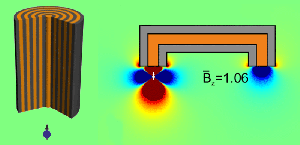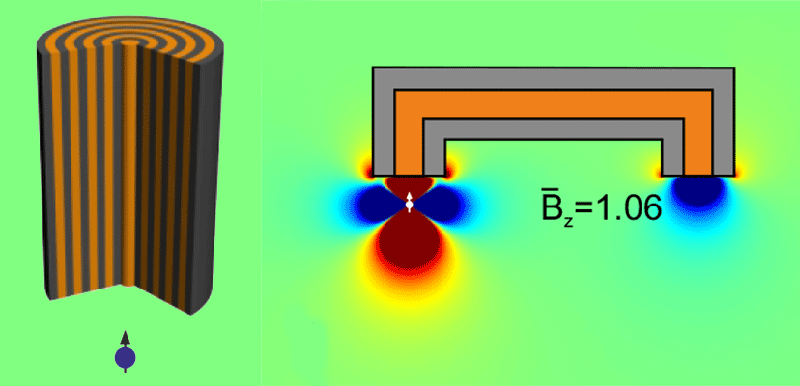Magnetic Hose Keeps Fields from Spreading
Much of modern technology rests on our ability to send electromagnetic waves from point A to point B with minimal loss of energy and information. Infrared waves confined to optical fibers carry data over the internet, whereas raw electric power is distributed to large cities through high-voltage transmission lines. Static magnetic fields are, however, much more difficult to channel long distance. Instead, these fields typically fall off quickly with distance from their source (usually a magnetic dipole.) A solution to this problem has now been proposed by Alvaro Sanchez of the Autonomous University of Barcelona, Spain, and his colleagues [1]. The authors, reporting in Physical Review Letters, have designed and tested a magnetic “hose” that channels the magnetic field from a source to a distance more than 10 centimeters away. Although magnetic flux guides already exist, the authors’ new design has the potential to transfer magnetic fields over longer distances without degradation, and could be used to increase the storage density of magnetic recording media, or to create higher resolution magnetic images of materials and devices, among other applications.
The magnetic hose (Fig. 1) designed by Sanchez and his colleagues consists of alternating concentric cylinders of a high-permeability material (a ferromagnet) and a low-permeability material (a superconductor). Roughly speaking, when a source field is placed at one end of the cylinder, the ferromagnetic shells magnetize and regenerate the source field along the length of the cylinder, while the superconducting shells keep the field lines from spreading outward. The authors show numerically that the hose is better able to transfer a field as more layers are added, but that even a simple two-layer design acts as an effective magnetic hose. As a proof of concept, the team made a two-layer magnetic hose, 14 centimeters long, out of a layer of superconducting yttrium barium copper oxide, wrapped around a cylinder made of a ferromagnetic iron alloy. Using a current-carrying loop as a source field, they showed the field strength transferred by their design was up to 4 times stronger than that transferred by a simpler hose made from only a ferromagnetic cylinder.
Physicists have known how to generate and manipulate static solenoidal magnetic fields for almost two centuries. But the design from Sanchez and co-workers grew out of the relatively new field of transformation optics, which is a mathematical framework for studying how materials with unusual dielectric and magnetic properties can distort the path of light. These materials can be engineered by building up arrays of components—such as superconductors or nanocircuits—into “metamaterials.” Transformation optics has inspired designs for “superlenses” that focus light beyond the diffraction limit, illusion optics that make one object look like another, single-layer metasurfaces with unusual refractive properties, and perhaps most spectacularly, “cloaks.” In principle, one can build a metamaterial structure around an object and have it disappear from view; the object casts no shadow and reflects none of the light impinging on it, rendering it effectively invisible. Various theoretical schemes for cloaking have been proposed [2,3], and a few experiments have shown limited evidence of invisibility [4].
The transformation optics behind cloaking offers a route from merely hiding an object immersed in a static magnetic field to actually transmitting the field a useful distance. Static magnetic field cloaking is, in principle, easier than cloaking light because the need to match the phase of the wave passing by and going through the cloak is eliminated, and the materials making up the cloak need to meet fewer requirements. The first proposal of a dc magnetic cloak [5] and early experimental implementations of it using superconductors [6] have inspired progress in the field of magnetostatic transformation optics [7]. For example, the traditional way to shield objects from external fields is to use materials with either a very high or near-zero permeability (i.e., μ metals and superconductors, respectively.) But these shields also distort field lines, making the object detectable. This problem can be avoided by using a shell made from a magnetically anisotropic material. The original concept, however, required the magnetic permeability to take extreme values near the inner and outer edges of the shell. A more recent proposal [8] by Sanchez and collaborators shows that a cylindrical shell with a locally uniform, but anisotropic permeability can work well as a cloak.
In 2012, researchers made the first experimental cylindrical dc magnetic cloak [9], which consisted of arrays of superconducting lead plates and ferromagnetic permalloy layers. This early magnetic cloak was effective at shielding its interior from externally applied magnetic fields. And the fields outside the shield, close to its surface, were almost completely unaltered by the presence of the cloak over a range of magnetic field values.
The same year, Sanchez and his colleagues built a much simpler dc magnetic cloak out of two coaxial cylinders; the inner and outer cylinders were made from rolled-up superconductor and ferromagnetic foil, respectively [10]. The design could only cloak an object from uniform external magnetic fields and the cloaking, while significant, was not complete. But its advantage was that it didn’t require any form of microfabrication and could be built from commercially available products.
To make the step from a magnetic cloak to a hose, Sanchez and his colleagues have taken advantage of the so-called magnetic transfer slab concept of transformation optics [1]. This slab has an infinite magnetic permeability perpendicular to the slab and zero permeability in the lateral directions. Such a structure will faithfully transfer the magnetic field entering on one surface through to the other surface, without distorting the fields outside the slab. A sufficiently large slab with such extreme values of permeability would be impractical to build, but the authors use a mathematical mapping to show that what seems like a vastly different structure—a multilayered finite cylindrical geometry—provides the equivalent static magnetic field transfer.
Magnetic hoses could have a number of interesting applications. High-permeability ferromagnetic “flux hoses” are currently used in scanning superconducting quantum interference device (SQUID) microscopes to improve the spatial resolution of magnetic-field images. This new flux hose idea can help to increase the signal-to-noise ratio of the images. Another application would be magnetic resonance imaging in which the patient and superconducting magnet required to generate the magnetic field could be physically separated, and the intense magnetic field could be applied locally to the patient through a magnetic hose. (In principle, what limits the length of the hose is the need to cool the superconducting shells to cryogenic temperatures.) One can also imagine creating magnetic flux circuits for various applications. For example, by tapering the geometrical scale of the hose, one can reduce the spatial extent of the field to enable nanoscale bit formation in magnetic media. Combinations of magnetic hoses could also be used to tailor the spatial shape of magnetic fields, making them more uniform, or creating large gradients, for example. Finally, magnetic hoses might be useful for quantum information processing, in which pin-point manipulation of quantum systems is required.
References
- C. Navau, J. Prat-Camps, O. Romero-Isart, J. I. Cirac, and A. Sanchez, “Long-Distance Transfer and Routing of Static Magnetic Fields,” Phys. Rev. Lett. 112, 253901 (2014)
- U. Leonhardt, “Optical Conformal Mapping,” Science 312, 1777 (2006)
- J. B. Pendry, D. Schurig, and D. R. Smith, “Controlling Electromagnetic Fields,” Science 312, 1780 (2006)
- D. Schurig, J. J. Mock, B. J. Justice, S. A. Cummer, J. B. Pendry, A. F. Starr, and D. R. Smith, “Metamaterial Electromagnetic Cloak at Microwave Frequencies,” Science 314, 977 (2006)
- B. Wood and J. B. Pendry, “Metamaterials at Zero Frequency,” J. Phys. Condens. Matter 19, 076208 (2007)
- F. Magnus, B. Wood, J. Moore, K. Morrison, G. Perkins, J. Fyson, M. C. K. Wiltshire, D. Caplin, L. F. Cohen, and J. B. Pendry, “A d.c. Magnetic Metamaterial,” Nature Mater. 7, 295 (2008)
- S. M. Anlage, “The Physics and Applications of Superconducting Metamaterials,” J. Opt. 13, 024001 (2011); P. Jung, A. V. Ustinov, and S. M. Anlage, “Progress in Superconducting Metamaterials,” Supercond. Sci. Technol. 27, 073001 (2014)
- A. Sanchez, C. Navau, J. Prat-Camps, and D. X. Chen, “Antimagnets: Controlling Magnetic Fields with Superconductor-Metamaterial Hybrids,” New J. Phys. 13, 093034 (2011)
- S. Narayana and Y. Sato, “DC Magnetic Cloak,” Adv. Mater. 24, 71 (2012)
- F. Gömöry, M. Solovyov, J. Šouc, C. Navau, J. Prat-Camps, and A. Sanchez, “Experimental Realization of a Magnetic Cloak,” Science 335, 1466 (2012)





